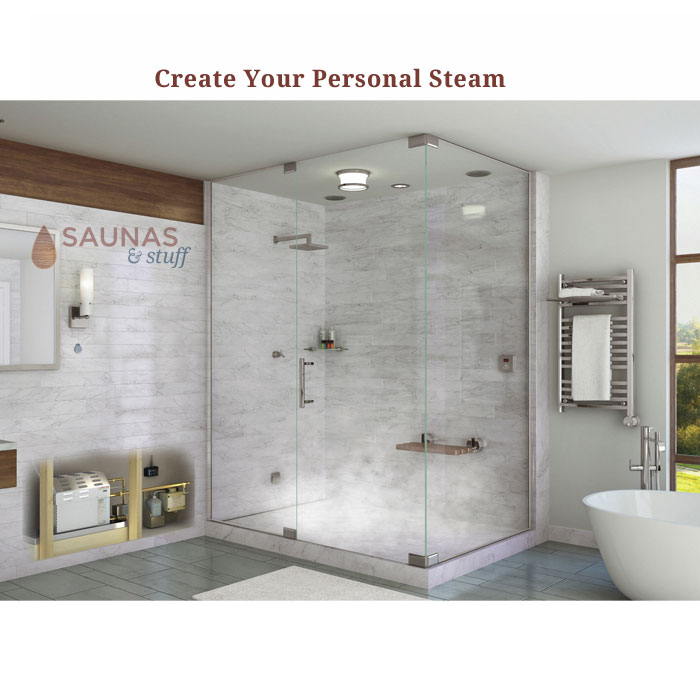
Oh the steam room--or what we like to call "wet saunas."
With a great deal of planning and a little hard work, you can build a steam room in your home as a great complement to your sauna, or to jazz up your bathroom.
Ready? Let's do this!
Making Choices
First, you need to decide: do you want to simply convert an existing shower/bath into a steam room, or are you going to build a steam room? There are also modular steam rooms/steam room kits you can buy that pretty much just need access to water and electricity.
You also need to figure out how many people you want to accommodate at one time. If converting a shower or bath, it might only have enough room for one.
There are several other things you'll need to think about when planning and designing the steam room:
- The door--It should swing outward, out of the steam room. Make sure it can open fully unobstructed.
- Steam outlets--The steam has to enter the room somehow. It will be hot! Generally, the outlets are low, near the floor. Put it somewhere it won't burn feet.
- Lights--You'll need IP-rated low voltage lights. You could have color light therapy if you wanted, too.
- Ventilation--When you open the steam room door, steam will escape. Make sure there is proper ventilation in the outer room to extract the steam.
Making More Choices
Converting an existing shower/bath is relatively easy: just install a steam proof door and a steam generator. Voila! A steam room!
We have great Tylo steam doors here, here, and here. And we have an amazing range of quality steam generators here.
But if you're building a steam room from the floor up, you need to think about ... well, about the floor. And up.
- Floor--As with just about every part of the steam room, the floor will need to be waterproof, especially where it connects with the exterior walls.
- Walls--These should be lined with tile-backer board.
- Benches/Seats--You can purchase ready-made benches and seats, or you can construct them in the same manner as the walls and line with tile-backer board before finishing.
- Ceiling--Build this the same way as the walls, being sure to construct a gradient that will allow condensation to drain away to one side rather than dripping down onto people's heads. It can have a central pitch, slope in one direction (a gradual slope of 2 inches/foot is adequate), or be domed, barrelled, or rolled. You will also need to determine how high the ceiling will be. For maximum steam build-up and to prevent cold spots, it should be lower than 8 feet high.
- Tiles--This is the most common way to finish the interior of a steam room. Ceramic is good. Granite is colder and will require a heftier steam generator. Just about anything will do, though, so long as it is non-porous.
- Grout and Adhesive--Anything that works for a shower will work for a steam room.
- Shower--As a nice option, you could install a shower in the steam room or nearby for post-steam showering.
- Other Accessories--There's a lot of other stuff you could put in a steam room, like a stereo system, MP3 jacks, or an automatic essence dosing system. Just make sure these accessories where constructed especially for use in a steam room.
Prepping the Space
You'll need to prepare the steam room location before you do any installation. Steam escaping from the steam room can and will seriously damage the infrastructure of the building in which it is housed. If the building is under construction, have the builders steam proof the room. For existing structures, have a contractor verify that the room can withstand steam. If it cannot, you will need to take steps to correct it.
Basic safe steam room installation include preventing steam from escaping, collecting condensed water before it drips on people, and draining water. To address these, the steam room should be properly sealed, insulated, have a sloping ceiling (see above) and have good drainage.
Time to Build!
When installing the door, consider this: small steam rooms (such as converted showers/baths) should have a small gap at the bottom of the door to permit air flow. Larger rooms can have an air-tight door.
All steam baths will need a generator of the proper size. Most manufacturers will provide guidelines to help you choose the right size. The materials used in the construction of the steam room will also determine what kind of generator to get. Once you've selected a generator, you will need to put it somewhere dry and accessible within 5 meters of the steam room, such as in a cupboard or garage. It should also be low-traffic and NOT located outdoors or in a space exposed to cold temperatures. It will need a water and electrical supply and you'll need to be able to run a copper pipe from the generator to the steam outlet in the steam room and control cables to the thermostatic control. The area will also need to be insulated with a drain nearby.
The electrical connection for the generator should be 240 volts. The water supply can be either hot or cold. Hot will create steam more quickly, obviously, but will require the generator to also be attached to a hot water heater.
When you have the generator properly installed and have it connected electrically to the control panel, plug it in and test it through the control panel. If everything is set up properly, it should light up.
At this point, if everything looks good, pat yourself on the back--good job! It wouldn't hurt to have a plumber and electrician come in and look at everything to make sure the installation is safe and solid. In any case, do not use the steam room for 24 hours. This gives all the connections time to dry.
It Doesn't Hurt to Get Some Help
The construction of a steam room and the installation of the generator can be done by anyone with moderate skills. However, if your skills are not up to it, or just to be safe, it doesn't hurt to have licensed professionals come in to help.
















